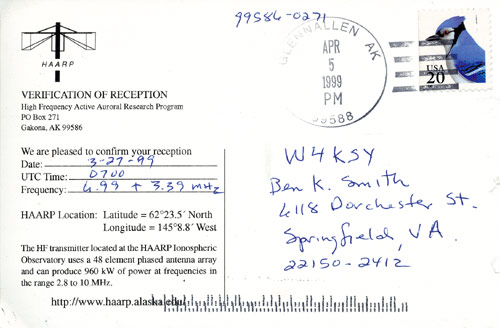


HAARP 1999 Gakona, Alaska
HAARP High Frequency Active
Auroral Research Program
This antenna system and station was proposed to be taken down!
Update July 30, 2015
The High Frequency Active Auroral Research Program will transfer from military into academic hands next month. After a swell of support last year from the scientific community and intervention by Alaska US Senator Lisa Murkowski, plus a lot of uncertainty before that, the US Air Force delayed its plans to shutter the ultra-high power HAARP and demolish it. Now the University of Alaska-Fairbanks (UAF) has won a bid to assume ownership of the facility near Gakona. That will happen on August 11.
Next month the facilities and equipment will formally transfer from the military to the university, UAF spokesperson Marmian Grimes told Alaska Public Media's KSKA in Anchorage. Grimes said the agreement is not open ended, but it will allow UAF access to HAARP for 2 years, during which time, the university and the Air Force can reach an agreement regarding the transfer of land.
In January, ARRL CEO David Sumner, K1ZZ, wrote the US Secretary of Defense to urge that HAARP be maintained in its current condition while UAF attempted to acquire the facility. "Most of our 164,000 members employ ionospheric propagation of HF radio signals for their communications and technical investigations," Sumner told then-Defense Secretary Chuck Hagel. "Ionospheric research therefore has great significance and importance to us."
As UAF's Grimes explained to KSKA, "Scientists would pay to use the facility for their research projects, and that would support operations, and is a common model for the university and research community."
Those who pushed for HAARP to remain open as a scientific research facility included several radio amateurs. UAF researcher and faculty member Chris Fallen, KL3WX, told ARRL this week that he had no information yet on the timing of the next experiment campaign or future operations, beyond what's already been reported in the news media. Fallen has conducted research at HAARP, and he was among those who had expressed concern last summer that HAARP's equipment was being carted off site for sale or disposal. He said little has been going on at HAARP since June 2014, and even with the transfer to UAF, it appears unlikely that any research would resume until the spring. "I have not visited the facility in more than a year," he said, "but my understanding is that most, if not all, of the important equipment has been returned, while 'junk' and other antiquated equipment from initial development and construction has been permanently removed."
Fallen told ARRL that he believes HAARP has "unique relevance to hams" and could become the sort of self-sustaining facility that UAF envisions. "Sustainable long-term success of the facility will depend on UAF's ability to secure funding from multiple sources for research operations, preferably including a large anchor tenant", he said this week.
HAARP was constructed in 1990 at a cost of some $300 million.
From the estate of W4KSY
Info used with permission of ARRL